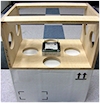When using your SAVER Field Instruments, it is important to develop a plan before beginning the data collection process.
Before any measurement, ask yourself, "what am I trying to learn?" By considering this ahead of time, you can tailor your approach to efficiently and effectively collect the information you need. Here are some of the project details to consider when developing your plan:
- Type(s) of data to collect (e.g. vibration, impacts, drops, or some combination)
- Recording setup
- Mounting location(s) and orientation(s)
- Mounting techniques
- Number of trips to record
- Instrument maintenance
Types of data

The types of dynamic events you wish to measure will determine the setup to use with your SAVER. You can tailor the setup to collect shock, impact, drop or vibration measurements for focused research - or you can use a more general setup to measure a variety of dynamics in a single session. With many SAVER instruments, you also have the ability to measure environmental conditions, such as temperature, humidity, and atmospheric pressure.
Recording setup

The source of the data can also impact the setup you choose to use with your SAVER. Are you targeting vehicle measurements, or maybe in-package measurements? Will you be measuring low-acceleration, long-duration events or alternatively high-acceleration, short-duration events?
The target event duration and acceleration levels will drive the recording setup. The overall duration of the trip / recording session is another important consideration. Are you collecting data for 30 hours or 30 days?
Mounting

Properly mounting the SAVER is probably one of the most critical steps for a successful field measurement. We want to make sure the SAVER is mounted as rigidly as possible to prevent erroneous data associated with rattling and ringing. If we don't get this right, the rattles and rings can obscure the measurements we're most interested in. Additionally, we want to document the mounting orientation so we can clearly relate the data to the real world - X, Y, and Z (side-to-side, front-to-back, up-and-down).
Number of trips

The more trips - the better! With large data sets, you have the opportunity to see trends emerge and develop an understanding for what is "normal". With an understanding of "normal", then we can begin to handle "abnormal". If feasible, it is always better to take multiple recordings when characterizing dynamic conditions. The recording setup and instrument mounting should be consistent from trip to trip to limit your variables. If you are making a critical one-time only measurement, consider using multiple instruments simultaneously to provide multiple points of view, as well as data redundancy.
Instruments maintenance

Always check the battery status and data communication before deploying SAVER's into the field. Verify the calibration status of your instrument before use, SAVER's are calibrated annually. Some applications present more challenges than others. Rest assured - our Data Analysis Center provides access to expertise - and we're always happy to help.